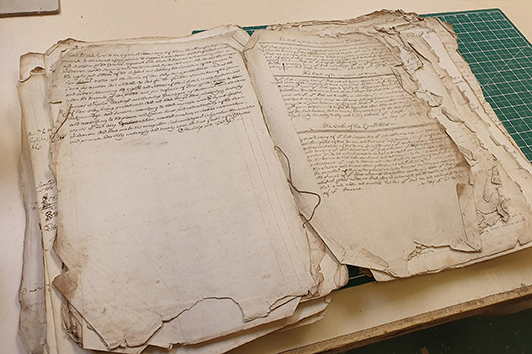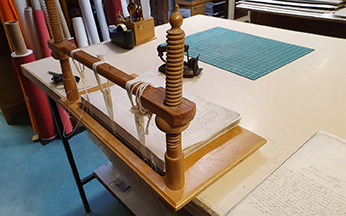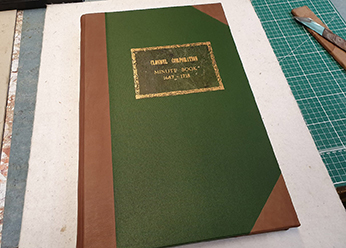CLONMEL CORPORATION MINUTE BOOK, 1687–1711
Published in Issue 1 (January/February 2022), Volume 30By Rachel Granville
6 April 2019, Lot 13—reading the catalogue for an upcoming auction at Whyte’s, I saw with a mixture of excitement and consternation that a minute book for Clonmel Corporation for the years 1692–1711 would soon be coming up for auction. While there is no question that such records belong in public ownership and ideally within the local authority that produced them, they do turn up at public auction; proof of ownership is difficult to establish and it was felt best that we purchase the manuscript rather than lose it (for a second time!) to private hands. The first time around, the book made its way from Clonmel Corporation into private hands via the Moore family, who were at the heart of the development of Clonmel town and borough during the late 1600s and early 1700s. Through their support of Cromwell, the Moore family, from very modest origins, prospered and moved from the ranks of merchants to landed gentry (to become Earls of Mountcashell). Michael Ahern mentions in Threads in a Clonmel tapestry that in 1725 Col. Moore refused to swear in Robert Hamerton as his successor and retained the mayoral regalia and corporation minute books, which gives us one explanation as to how the minute book passed from the town council’s control. And it was through the Moore family, in a roundabout way, that it resurfaced.
The book was auctioned as part of the estate of the late Catherine (Kitty) Mary Fleming. The Fleming family had been long associated with the Earls of Mountcashell. According to Turtle Bunbury, the two families were very close and when Horace Holroyd-Smyth (a descendant of the Moores) died in 1969, Fleming was one of the executors of his will. She died in 2015, hence the minute book of the Corporation of Clonmel reappeared at her estate auction.

Above: The Clonmel Corporation minute book before restoration, with no binding and with soiling, stains and dog-ears on every page.
When we acquired the book, we discovered that it began in 1687 rather than 1692 and that it was in very poor condition. It was comprised of 104 pages, with no binding; all pages displayed tears, spine and fore-edge damage and evidence of poor handling, with soiling, stains and dog-ears on every page.
Paul and Sharon in Muckross Bookbindery had their work cut out for them! They painstakingly restored the volume, first treating and then repairing the paper before the pages were rearranged back into the original format. Conservator Paul Curtis made the invaluable suggestion that we scan the individual pages at this stage before they were sewn and rebound, thus creating a digital record without damaging the fragile pages. Once scanned, the pages were carefully collated and folded and sewn in original sections, before the volume was covered in the style of the period.

Above: Restoration in progress at Muckross Bookbindery.
As a result of all of this fantastic work, we now have a reasonably robust volume, although thanks to the digitisation process we aim to keep physical access to a minimum. We are very happy, however, that the information within the volume is now accessible, information that very much reflects the time in which it was written.
By the 1690s, as a result of Cromwellian settlement, British Protestants controlled three quarters of all lands and almost all of the houses in the walled towns of Ireland. This was also the case in Clonmel, where urban dominance by Protestant settlers enabled various categories of merchants to progress to the ranks of the landed gentry. According to David J. Butler in South Tipperary 1570–1841: religion, land and rivalry, Clonmel was particularly noteworthy in the raising of entrepreneurial families to the landed gentry. Families such as Carleton, Hammerton, Kellet and Perry progressed to ownership of landed estates in the period. The most successful of all, however, was Richard Moore, who came to Clonmel around 1655 and who by the time of his death was in possession of extensive estates in Tipperary. This minute book provides a unique view into this world, into how this urban dominance gave control of the town and surrounding areas to the emerging Protestant gentry. While Catholics were allowed to trade in the town—the entry of 1 November 1695 notes that Papists and Quakers are allowed to trade—restrictions on Catholics are frequently referenced; for example, an entry of 16 March 1696 outlines that all Papist houses are to have soldiers ‘quartered upon them for preventing cabals & meetings’.

Above: The cover of the restored, bound copy.
By the late seventeenth century, electoral franchise and selection for positions in Irish local government were directly linked with loyalty to the Crown. The Corporation of Clonmel was keen to emphasise its loyalty to the reigning monarchs, William and Mary (1689–1702) and Queen Anne (1702–14). For example, the minutes for 3 April 1695 record the Corporation considering ‘with horror & detestation … the most execrable & Horrid Plott for the assassination of your Ma[jes]ties royall p[er]son’, while the minutes of 15 September 1709 record the Corporation ‘rejoyceing for the greate & glorius victory lately obtained by her ma[jes]ties & her Allies Armes over the French’ in Flanders.
The volume records the town’s administration and includes the elections of mayors, councillors and bailiffs; appointments and resignations to positions and committees; attendances at quarterly meetings; freemen; details of oaths of allegiance; and issues relating to the day-to-day functioning of the town. These include cases of trespass; details of boundaries and common areas—for example, commons are set (5 February 1693) and ‘leases & liberties on the commonage’ (22 January 1699); and town walls and roads—for example, permissions are granted to make doors in the town walls (25 May 1694) and a road to the ‘Spaw well at the foot of the mountains’ is to be built (2 August 1693). We see Clonmel emerging as a commercial centre, with constables required to list ‘trades callings or vocations’ of ‘inmates’ and ‘tax and contributions’ to be paid ‘according to theire dealing of advantage in town’ (8 February 1687), while properties are to be kept ‘free of dung & dirt’ on fair days (24 August 1696). These, however, are only a few examples.
The minute book has been beautifully conserved by the fantastic conservators at Muckross Bookbindery, to whom we are extremely grateful. Many thanks are also due to Creative Ireland, who financed the digitisation of the book, which allows us to share it with you via our website:
https://www.tipperarycoco.ie/your-council/clonmel-town-council-minute-book-1687%E2%80%931718.
Rachel Granville is an archivist with Tipperary County Council.
















